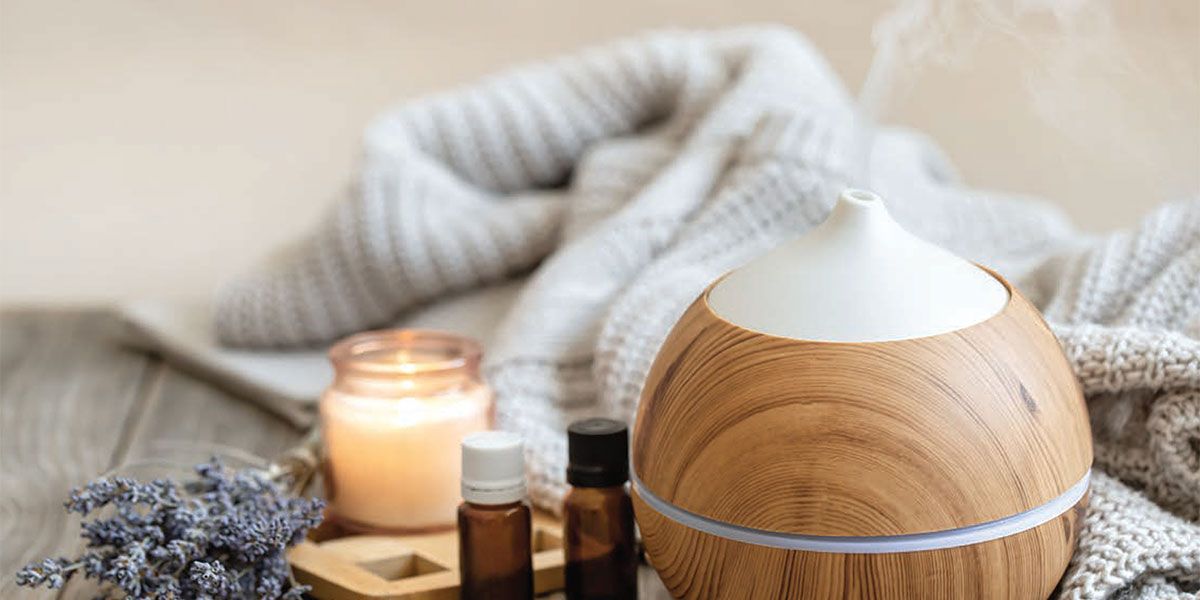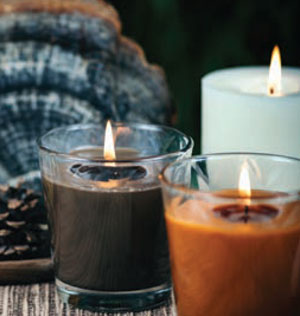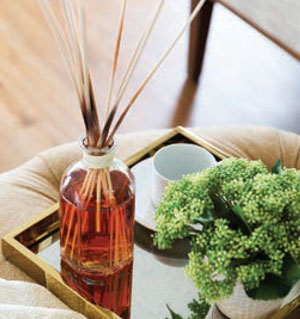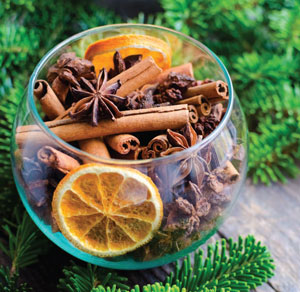The Art of Fragrance | Scenting Your Home for Maximum Enjoyment

Because of the position of the olfactory system in the brain, scent has the power to trigger emotions, memory and creativity. Perhaps you’ve experienced the jolt of memory caused by a stranger’s perfume or a nostalgically familiar laundry detergent. Realtors have been known to pop cookies into the oven to infuse the house with a delicious smell (and perhaps raise potential buyers’ endorphin levels) to set the stage for a positive showing.
According to the Sense of Smell Institute, the average person is able to distinguish over 1,000 different odors. Some of the top 10 that trigger happy feelings include the smell of baking bread or cookies, vanilla, freshly mowed grass, pine, citrus and baby powder. When it comes to your home, there is a unique smell to it, even if you can’t detect it. Within the space of just a few breaths, we can lose our ability to detect new odors due to olfactory adaptation. But if you go on vacation and return to your home, you will notice its unique smell.
Today the aroma of a home is a big business that markets ways to not only clean your home but enhance its scent. Oddly enough, a clean home should smell like nothing. Masking unpleasant odors with cleaning products is never the way to go. If you want to improve or change the scent of your home, you need to clean first and scent later.
There are certain unpleasant odors and problem areas that should be tackled first if you notice them. Moisture is the number one cause of household odors. Musty smells are often the result of mold or mildew that thrive in areas that don’t get much ventilation. Dehumidifiers help here. You can counter mustiness by regularly cleaning your trash cans, washing machine and dishwasher.
A monthly inventory of your fridge to ensure that contents are fresh will help prevent bad smells. Wipe down the inside, including shelves and drawers, with a 1-to-1 mixture of hot water and white vinegar with a tiny drop of dish soap.
Bedding, carpets, throw pillows and window coverings attract smells. While you can’t launder your mattress, you can sprinkle baking soda on it and vacuum it like a carpet. If the care labels on these items indicate they can be machine washed, they should be cleaned regularly. And if you have pets, you absolutely need to vacuum often. A sprinkle of baking soda 20 minutes prior to vacuuming will help neutralize any smells.
 Once your home is clean, you can add in a subtle scent with essential oils (highly concentrated extracts from flowers, leaves and other plant parts), candles or diffusers. A drop or two of your favorite essential oil on your air filter will help circulate a signature scent. Candles offer a quick way to infuse a room with a favorite scent, and soy wax gives you the cleanest burn. To extend the shelf life of a candle, burn a new one for three to four hours, rather than a few minutes, so that the wax pools across the container from rim to rim. Wax has memory and won’t pool past the circumference of the previous burn; it will tunnel down, causing waste. Trim wicks to 1/4 inch prior to each burning, and upcycle the container when the candle is burned away.
Once your home is clean, you can add in a subtle scent with essential oils (highly concentrated extracts from flowers, leaves and other plant parts), candles or diffusers. A drop or two of your favorite essential oil on your air filter will help circulate a signature scent. Candles offer a quick way to infuse a room with a favorite scent, and soy wax gives you the cleanest burn. To extend the shelf life of a candle, burn a new one for three to four hours, rather than a few minutes, so that the wax pools across the container from rim to rim. Wax has memory and won’t pool past the circumference of the previous burn; it will tunnel down, causing waste. Trim wicks to 1/4 inch prior to each burning, and upcycle the container when the candle is burned away.
 There are a variety of diffusers on the market, ranging from the simple to the luxurious. Reed diffusers consist of a vessel containing fragrance oil into which reed or rattan sticks are inserted. They absorb the scent like little straws, moving it up the length of the reed to the top where it evaporates and disperses the fragrance into the air.
There are a variety of diffusers on the market, ranging from the simple to the luxurious. Reed diffusers consist of a vessel containing fragrance oil into which reed or rattan sticks are inserted. They absorb the scent like little straws, moving it up the length of the reed to the top where it evaporates and disperses the fragrance into the air.
Ultrasonic diffusers use electronic frequencies to create vibrations in water, which then create a fine mist of water and essential oils that is released into the air. Since these diffusers utilize water, some people choose them in winter to help humidify dry air.
A lampe berger is a heat diffuser that marries a beautiful container with air purifying and perfuming capabilities. The lamp was initially invented in 1898 to help with disinfection in hospitals. A lampe berger uses a catalytic burner that heats to burn an alcohol-based liquid fuel. In just 20 minutes, the alcohol releases molecules into the air that eliminate odor while diffusing scent at the same time.
 The smells that you’ll enjoy the most in your house this time of year are the ones that recall favorite memories of past holidays. Winter may be all about cozying up inside by a fire, but some of the most traditional scents are those found in nature. A stovetop potpourri can fill your house with a variety of delicious smells. Try cinnamon sticks, cardamom pods, cloves, citrus peels, fresh ginger, pine sprigs or vanilla extract. A favorite meal in the crockpot or gingerbread cookies in the oven are also surefire ways to infuse your home with the holiday spirit. ✦
The smells that you’ll enjoy the most in your house this time of year are the ones that recall favorite memories of past holidays. Winter may be all about cozying up inside by a fire, but some of the most traditional scents are those found in nature. A stovetop potpourri can fill your house with a variety of delicious smells. Try cinnamon sticks, cardamom pods, cloves, citrus peels, fresh ginger, pine sprigs or vanilla extract. A favorite meal in the crockpot or gingerbread cookies in the oven are also surefire ways to infuse your home with the holiday spirit. ✦
Baby Powder, Baking Bread Or Cookies, baking soda, candles, Citrus, Dehumidifiers, essential oils, Extracts, flowers, Fragrance, Fragrance Oil, Freshly Mowed Grass, Lampe Berger, Leaves, Olfactory System, Pine, Rattan Sticks, Reed Diffusers, Scent, Ultrasonic Diffusers, Vanilla






